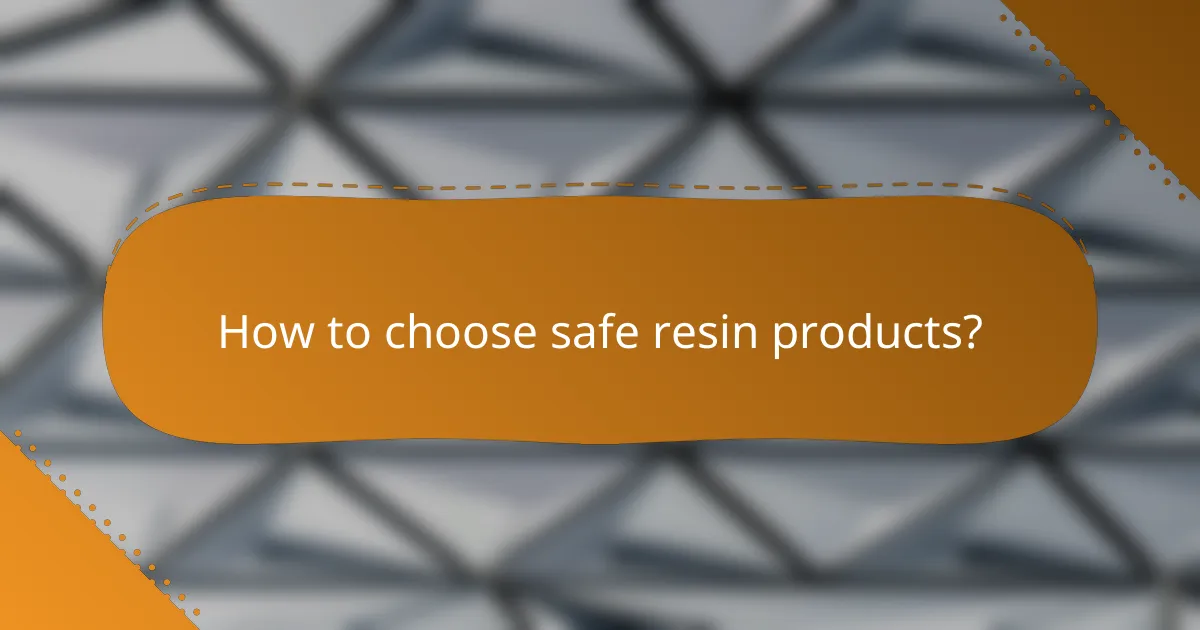Understanding resin safety is crucial for beginners to ensure a safe and enjoyable crafting experience. By prioritizing protective gear, proper ventilation, and safe storage practices, users can significantly reduce the risks associated with resin, such as skin irritation and respiratory issues. Selecting safe resin products and being informed about their potential hazards will further enhance safety in your workspace.

What safety measures should beginners take when using resin?
Beginners using resin should prioritize safety by wearing protective gear, ensuring proper ventilation, and following storage guidelines. These measures help minimize exposure to potentially harmful chemicals and create a safer workspace.
Wear protective gear
Always wear personal protective equipment (PPE) when working with resin. This includes gloves, goggles, and a mask to prevent skin contact, eye irritation, and inhalation of fumes. Choose nitrile gloves for better chemical resistance and ensure your mask is rated for organic vapors.
Consider wearing long sleeves and an apron to protect your skin and clothing from spills. Regularly check your gear for any damage and replace it as necessary to maintain effective protection.
Work in a well-ventilated area
Proper ventilation is crucial when using resin to disperse harmful fumes. Work outdoors if possible, or in a space with open windows and fans to circulate air. If indoors, consider using an air purifier with a HEPA filter to further reduce airborne particles.
A well-ventilated area not only protects your health but also helps the resin cure properly. Avoid working in small, enclosed spaces where fumes can accumulate, as this increases the risk of respiratory issues.
Use appropriate storage containers
Store resin and hardeners in their original containers or in clearly labeled, airtight containers to prevent contamination and spills. Ensure these containers are made from materials compatible with the chemicals, such as polyethylene or glass.
Keep storage containers in a cool, dry place away from direct sunlight and heat sources. This helps maintain the integrity of the resin and reduces the risk of accidental exposure.
Follow manufacturer guidelines
Always read and adhere to the manufacturer’s instructions for mixing, curing, and safety precautions. Each resin product may have specific requirements regarding ratios, curing times, and safety measures.
Familiarize yourself with the safety data sheet (SDS) provided with the resin, as it contains vital information about hazards, handling, and first aid measures in case of exposure.
Keep away from children and pets
Resin can be hazardous, so it’s essential to keep your workspace off-limits to children and pets. Store resin materials in locked cabinets or high shelves to prevent accidental access.
Educate family members about the dangers of resin and the importance of safety measures. This ensures a safer environment for everyone while you work on your projects.

What are the health risks associated with resin?
Resin can pose several health risks, particularly if safety precautions are not followed. Common issues include skin irritation, respiratory problems, allergic reactions, and potential long-term effects from prolonged exposure.
Skin irritation
Skin irritation is one of the most immediate risks when working with resin. Contact with uncured resin can lead to redness, itching, or rashes. It’s crucial to wear protective gloves and clothing to minimize skin exposure.
If irritation occurs, wash the affected area with soap and water immediately. For severe reactions, consult a healthcare professional for appropriate treatment.
Respiratory issues
Inhaling fumes from resin can lead to respiratory issues, including irritation of the throat and lungs. This is particularly a concern in poorly ventilated areas. Always work in a well-ventilated space or use a respirator to protect against harmful vapors.
Signs of respiratory distress may include coughing, wheezing, or shortness of breath. If symptoms persist, seek medical attention promptly.
Allergic reactions
Some individuals may develop allergic reactions to resin components, which can manifest as skin rashes or respiratory problems. It’s advisable to conduct a patch test before extensive use, especially for those with known sensitivities.
Be aware of symptoms such as swelling, hives, or difficulty breathing, and discontinue use immediately if these occur. Consulting an allergist may be beneficial for those with severe reactions.
Long-term exposure effects
Long-term exposure to resin can lead to chronic health issues, including skin sensitization and respiratory conditions. Continuous inhalation of fumes may increase the risk of developing more serious respiratory diseases over time.
To mitigate these risks, limit exposure time and ensure proper ventilation. Regular breaks and the use of protective equipment can significantly reduce the likelihood of long-term health effects.

How to choose safe resin products?
Selecting safe resin products involves looking for specific labels, checking safety documentation, researching brands, and considering eco-friendly alternatives. Prioritizing these factors can help ensure a safer experience when working with resin.
Look for non-toxic labels
When choosing resin, always look for products that are labeled as non-toxic. This indicates that the resin has been formulated to minimize harmful effects on health when used as directed.
Common certifications to look for include ASTM D-4236 and EN-71, which signify compliance with safety standards. These labels provide reassurance that the resin is safer for both users and the environment.
Check for safety data sheets
Safety Data Sheets (SDS) provide detailed information about the hazards associated with a resin product. Always review the SDS before purchasing to understand the potential risks and necessary safety precautions.
The SDS will outline important details such as handling instructions, first aid measures, and personal protective equipment (PPE) recommendations. This information is crucial for ensuring safe usage and minimizing health risks.
Research reputable brands
Invest time in researching brands known for their commitment to safety and quality. Look for companies with a history of transparency regarding their ingredients and manufacturing processes.
Read reviews and seek recommendations from experienced users in online forums or social media groups. Established brands often have a track record of producing reliable and safe resin products.
Consider eco-friendly options
Eco-friendly resin options are increasingly available and can be a safer choice for both users and the environment. These resins typically use plant-based materials and have lower levels of volatile organic compounds (VOCs).
When selecting eco-friendly resins, look for certifications like Green Seal or similar eco-labels. These certifications indicate that the product meets specific environmental standards, making it a responsible choice for your projects.

What are the best practices for resin disposal?
Proper resin disposal is crucial for safety and environmental protection. Following established practices ensures that resin waste is managed responsibly and complies with local regulations.
Follow local regulations
Each region has specific laws governing the disposal of hazardous materials like resin. Familiarize yourself with these regulations to avoid fines and ensure safe practices. Check with local environmental agencies for guidelines that apply to your area.
Regulations may include requirements for labeling, storage, and transportation of resin waste. Adhering to these rules helps protect both public health and the environment.
Use designated disposal facilities
Always dispose of resin at facilities specifically designed for hazardous waste. These locations are equipped to handle and process materials safely, reducing the risk of environmental contamination.
Look for local recycling centers or hazardous waste collection events that accept resin. Many communities offer drop-off days or permanent facilities for safe disposal.
Avoid pouring down the drain
Pouring resin down the drain is illegal and harmful to water systems. It can cause blockages and contaminate water supplies, posing risks to both human health and aquatic life.
Instead, collect resin waste in a sealed container and take it to a designated disposal facility. This simple step ensures compliance with regulations and protects the environment from hazardous materials.


